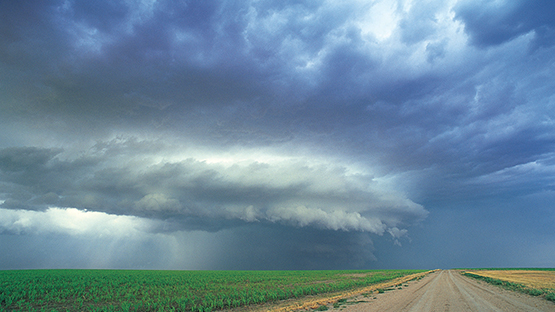
When you see a storm on the horizon or on your phone’s radar, are you comfortable with the hail coverage you have in place to protect your crop? Did you elect enough multi-peril coverage? As a producer, you have the opportunity to protect your crop with multiple hail insurance options in addition to your multi-peril insurance coverage. It’s important to determine how much is necessary for your operation.
The hail coverage you need is subject to your multi-peril unit structure
If you chose to have Enterprise Units (‘EU’ – where all acres of the same crop in the same county are combined) on your multi-peril policy, any loss is averaged across the whole Enterprise Unit. So while you may have an entire field wiped out, the average may make you not eligible for a claim. However, hail insurance losses are determined on a per field basis. This means that even if you chose to have Enterprise Units for your multi-peril policy, you can use hail insurance to make sure that your individual fields will be eligible to receive payment if you suffer from a hail loss.
Because of this, the unit structure on your multi-peril policy is an important consideration when choosing your hail insurance coverage levels. If EU are elected on your multi-peril policy, you may want to increase the amount of hail coverage you have in place to manage risk on your unprotected crop.
For example, suppose your multi-peril coverage was selected at a 70% coverage level on the fields below. You take 70% of your APH to find your guarantee.
Field A: APH: 195; Guarantee: 137 (195 x 70%)
Field B: APH: 130; Guarantee: 91 (130 x 70%)
This results in a 114 guarantee per unit average. If you average more than 114 bu/acre, then you have no indemnity with your multi-peril coverage regardless of loss on an individual field, even if it’s less than your guarantee. If Field B’s yield meets its APH, Field A could technically suffer a 97 bu/acre loss that would be completely uncovered. This is where it’s important to realize how using a hail policy to compensate can be extremely beneficial to your operation.
Traditional Hail and Production Hail – which is right for your operation?
Traditional Hail products protect up to the actual value of your crops. You can elect dollars per acre that you want your crop to be insured at. There are different Traditional policy options to fit any producer - no deductible, multiple deductible options and increased payout to name a few. With a Traditional policy you can add additional coverage to your crop if yield forecasts look really good as the growing season continues. You can also choose more than one policy to protect your crop. For example, a no deductible policy could be paired with a high deductible policy if it looks like you will have a bumper crop. Something else to keep in mind when looking at traditional policies is that hail loss payouts are not determined by your production.
For example, if you have a 10% hail loss on a field that you have $250 of coverage on a basic policy, then you would get a $25.00 per acre payment, regardless of what your crop produces. Every plan is different, but with a basic policy a 10% loss gets you 10% of your total coverage purchased on that plan.
10% hail loss, $250 hail coverage per acre (basic policy)
$250 x 10% = $25 per acre payment
Production Hail combines your existing multi-peril coverage with your hail coverage. The production plan adds back the deductible that you’ve chosen based on the coverage level that you elected for your multi-peril policy. A typical production hail policy will insure your Actual Production History (APH) up to 120% and up to 100% of the Revenue Protection (RP) or Yield Protection (YP) projected price.
For example, suppose the APH for one of your corn fields is 175 bushels per acre. With a 120% production plan, you now have a modified guarantee of 210 bushels per acre. This means that your production hail policy will pay out up to 210 bushels if you suffer a hail loss.
APH of 175 bushels per acre, 120% production hail plan
175 x 120% = 210 bushels per acre modified guarantee
For another example let’s suppose the adjustment is set at a 10% loss with the crop adjuster. After reporting your production, the loss comes out to be an 8% loss on the same field that had a 10% loss when it was adjusted. You will get paid on the lessor of the two losses (8%) for your hail indemnity payment.
This works the same way in that if the adjustment is set at a 10% loss with the crop adjuster and after reporting your production the loss comes out to be a 15% loss. You will get paid the lessor of the two losses (10%).
The Production Hail policy is a great tool in managing risk when you do not foresee your crop outgrowing its modified guarantee – if you outgrow your modified guarantee you will not receive an indemnity. With increasing APHs in our area in recent years, the production plans are becoming more costly every year. The higher the APH, the more crop there is to insure. Traditional plans, however, do not increase their rates based on production. Rates for traditional plans are increased based on loss history in your area.
It’s important to know that there isn’t a ‘one size fits all’ when it comes to crop insurance. It requires a large amount of analysis, so contact your AgCountry Insurance Specialist to help determine which policy is best for your operation.



